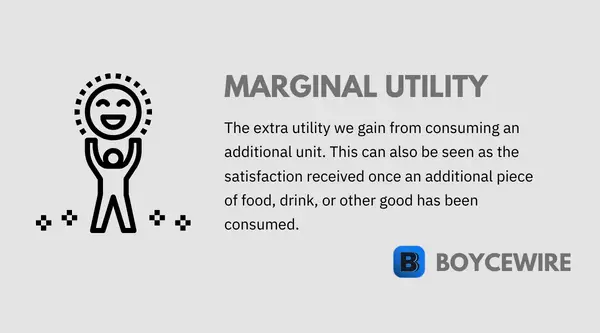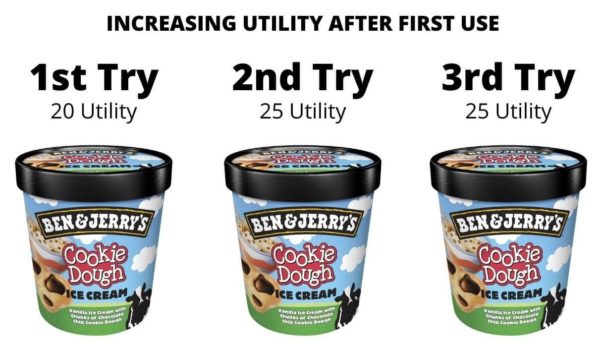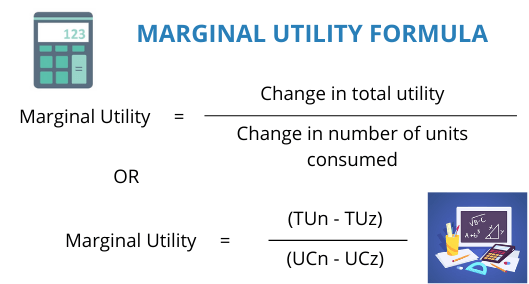Table of Contents ![]()
Marginal Utility: Definition, Formula & Example

What is Marginal Utility?
Utility is the benefit and enjoyment we receive from consuming a product or service. So when we eat dinner, we gain a certain level of utility which could also be described as satisfaction. With that said, utility can vary. For example, we may gain more utility from eating at an expensive a la carte restaurant, as opposed to McDonalds. In other words, utility measures our preferences and how much we are willing to pay for it.
Marginal Utility is the enjoyment a consumer gains from each additional unit they consume. It calculates utility beyond the first product consumed (the marginal amount).
For example, you may buy an iced doughnut. In turn, you receive a certain level of utility or satisfaction from it. After that, you may decide to buy another, receiving further utility and satisfaction. The utility gained from the second doughnut is the Marginal Utility. In other words, the utility received above a certain point.
Key Points
- Marginal Utility (MU) is the enjoyment a consumer gains from each additional unit they consume.
- It starts to diminish after each unit consumed as enjoyment of another unit declines.
- The formula for MU is change in total utility / change in number of units consumed.
Understanding Marginal Utility
We can define Marginal Utility as the utility, satisfaction, or enjoyment from each additional unit consumed. Businesses can find this useful when considering new products or services to offer.
For example, a consumer may receive a set amount of utility from one piece of chocolate. Subsequently, for each piece after, utility may start to fall. What’s more, it will continue to fall until there is no further utility/satisfaction.

Chocolate manufacturers were able to identify this and come up with a solution. To explain, marginal utility (MU) can diminish in a short period of time. However, over time, the MU of their chocolates can remain consistent. In other words, the consumer enjoys the chocolate just as much if they eat it today or the next day. So long as consumption is spaced out.
As a result, manufacturers designed a re-sealable pouch. In short, this allows the business to sell larger quantities. At the same time, consumers can delay consumption to maximize their utility.
How Time and First Use Matters
Utility can vary over time and moods. When some feel upset and down, a big tub of ice cream meets a consistent level of enjoyment and utility. In a similar fashion, an addicted alcoholic may value the next bottle as much as the last; perhaps even more so.

We can look at increasing Utility in two ways: time and first-use. For instance, time of consumption can be important. If we look at instant consumption, we are more likely to see Diminishing Utility. We are less likely to enjoy another chocolate bar if we have recently eaten one. By contrast, when consumption occurs at a later date, we may, in fact, see higher levels of utility.
This feeds us into ‘first-use’. Most of us will be able to remember the first time we tried food we haven’t tasted before. Perhaps it was a Chicken Curry or a Lean cut Steak. We may have loved it so much that we had to get it again, again, and again. Sometimes the second or third servings provide greater utility than the first. This is because it satisfies a craving. A craving that was trigger by the first-use sensation.
What is Diminishing Marginal Utility
Diminishing Marginal Utility is simply the theory that consumers tend to value a product or service less the more they consume. This concept can help us understand why some consumers behave in different ways.
“Diminishing Marginal Utility is where the consumer values each additional unit less and less the more they consume.”
Let us take mobile phones as an example. For instance, the new iPhone may have just come out and Jeffery goes straight to the store to pay $799 for it. Jeffery goes home, opens it up and starts using it straight away. His level of utility is extremely high. At the same time, the Marginal Utility he would receive from buying another is virtually zero; there could be an argument that it would be negative.
Nevertheless, his utility is well and truly diminished. However, over time, Jeffery may start taking his phone for granted. His daily utility of using the phone starts to decrease. In turn, the utility of purchasing the next new iPhone starts to increase.
Marginal Utility Formula
Total utility is the enjoyment or satisfaction we receive once we consume a product or service. We therefore work out Marginal Utility by subtracting the previous total utility from the new total.
The marginal utility formula is change in total utility / change in number of units consumed.
Alternatively, it can be calculated by taking total utility consumed at point ‘n’ and subtracting it by total utility consumed at point ‘z’ – where point ‘n’ is the new level of utility, and point ‘z’ is the old point. To calculate marginal utility, this would then be divided by the sum of number of units consumed at point ‘n’, minus the number of units consumed at point ‘z’.

In the table below, let’s say it shows how Mr Ebb receives utility for a bag of chips. At one bag he receives 20 utility. At two bags, he receives a total of 35 utility. We therefore work out the margin by finding the difference between the two. So in this example, it would be 35 – 20 = 15.
| Quantity Consumed | Total Utility | Marginal Utility | Average Utility |
|---|---|---|---|
| 1 | 20 | 20 | 20 |
| 2 | 35 | 15 | 17.5 |
| 3 | 47 | 12 | 15.66 |
| 4 | 55 | 8 | 13.75 |
| 5 | 60 | 5 | 12 |
Marginal Utility Example
There are two people, David and Susan. David has 4 doughnuts, whilst Susan has 20. They both decide to go and purchase another doughnut from the store. This increases David’s total from 4 to 5. In turn, his utility increases and the number of doughnuts he has increased by 25 percent.
Susan also purchases another doughnut, bringing her total from 20 to 21. Her utility also increases, but her total number of doughnuts only increases by 5 percent.
What we can take away from this example is that the greater quantity an individual has, the lower their marginal utility. So as Susan acquires more doughnuts, the utility she receives from each additional (marginal) doughnut falls. This will continue to fall until the satisfaction received is less than the value placed on that additional level of enjoyment.
Related Topics
FAQs
If you open up a packet of biscuits, you may enjoy the first one. This is known as utility. However, the second, third, and fourth biscuit may provide a different level of enjoyment. This could be more, or perhaps less. Nevertheless, it is the additional biscuit or the marginal consumption, that is classed as marginal utility. In other words, it is the enjoyment or satisfaction that a consumer gains for each additional unit they consume.
You can calculate it using the formula:
Marginal Utility = Change in Total Utility – Change in Number of units consumed
Diminishing Marginal Utility is where the consumer values each additional unit less and less the more they consume.
Utility is the benefit and enjoyment we receive from consuming a product or service. By contrast, Marginal Utility is the enjoyment or satisfaction that we gain for each additional unit we consume
Further Reading
 Adverse Selection: (Definition & 4 Examples) - Adverse selection is where one individual in a transaction has more information about the good than the other.
Adverse Selection: (Definition & 4 Examples) - Adverse selection is where one individual in a transaction has more information about the good than the other.  Unit Elastic - Unit elastic demand refers to a situation where a change in price leads to an equivalent proportional change in quantity…
Unit Elastic - Unit elastic demand refers to a situation where a change in price leads to an equivalent proportional change in quantity…  Autarky Definition and Examples - Autarky is a self-sufficient economic state without international trade, but can limit growth due to higher costs, limited access to…
Autarky Definition and Examples - Autarky is a self-sufficient economic state without international trade, but can limit growth due to higher costs, limited access to… 